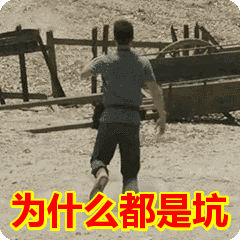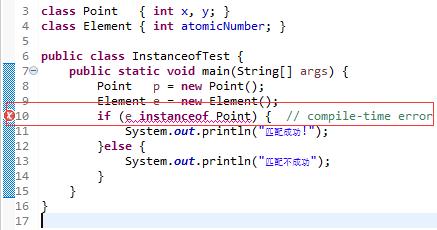背景故事
《曾经最美》是朱铭捷演唱的一首歌曲,由陈佳明填词,叶良俊谱曲,是电视剧《水晶之恋》的主题曲。歌曲时长4分28秒。 歌曲歌词:
看不穿你的眼睛
藏有多少悲和喜
像冰雪细腻又如此透明
仿佛片刻就要老去
整个城市的孤寂
不止一个你
只能远远的
想像慰藉我们之间的距离
我又不是你的谁
不能带给你安慰
忍心你枯萎凋零的玫瑰
仿佛希望化成灰
要不是痛彻心扉
谁又记得谁
只是云和月
相互以为是彼此的盈缺
不能哭喊已破碎
曾经的最美
独自一个人熟悉的街
别问你在想谁
不去追悔已憔悴
爱过的机会
真实已粉碎人事已非
还有什么最可贵
我又不是你的谁
不能带给你安慰
忍心你枯萎凋零的玫瑰
仿佛希望化成灰
要不是痛彻心扉
谁又记得谁
只是云和月
相互以为是彼此的盈缺
不能哭喊已破碎
曾经的最美
独自一个人熟悉的街
别问你在想谁
不去追悔已粉碎
爱过的机会
真实已粉碎人事已非
还有什么最可贵
不能哭喊已破碎
曾经的最美
独自一个人熟悉的街
别问你在想谁
不去追悔已憔悴
爱过的机会
真实已粉碎人事已非
还有什么最可贵
牵线之牛刀小试
如何判断是不是谁的谁?java有一个instanceof操作符(关系操作符)可以做这件事。
public static voidmain(String[] args) {
String s= "Hello World!";
System.out.println(sinstanceofString);
}
打印出结果true
可是如果你的哪个谁不存在呢?请看代码:
public static voidmain(String[] args) {
String s= null;
System.out.println(sinstanceofString);
}
很多人都会异口同声的说
false

你答对了。
JSL-15.20.2规定
At run time, the result of the instanceof operator is true if the value of the RelationalExpression is not null and the reference could be cast to the ReferenceType without raising a ClassCastException. Otherwise the result is false.
牵线之乱点鸳鸯谱
如果没有任何关系的两个类使用instanceof会如何?
class Point { intx, y; }class Element { intatomicNumber; }public classInstanceofTest {public static voidmain(String[] args) {
Point p= newPoint();
Element e= newElement();if (e instanceof Point) {
System.out.println("匹配成功!");
}else{
System.out.println("匹配不成功");
}
}
}
不少人会说:“匹配不成功”

抱歉,你又掉进坑里了,这个会报编译错误

JSL-15.20.2规定
The type of the RelationalExpression operand of the instanceof operator must be a reference type or the null type, or a compile-time error occurs.
It is a compile-time error if the ReferenceType mentioned after the instanceof operator does not denote a reference type that is reifiable (§4.7).
If a cast of the RelationalExpression to the ReferenceType would be rejected as a compile-time error (§15.16), then the instanceof relational expression likewise produces a compile-time error. In such a situation, the result of the instanceof expression could never be true.
当然,cast也会是编译错误
class Point { intx, y; }class Element { intatomicNumber; }public classInstanceofTest {public static voidmain(String[] args) {
Point p= newPoint();
Element e= newElement();
p= (Point)e; //compile-time error
}
}
牵线之暗藏玄机
编译器并不是万能的,并不能检测出所有问题,看下面:
class Point { intx, y; }class Element { intatomicNumber; }public classInstanceofTest {public static voidmain(String[] args) {
Point p= newPoint();//Element e = new Element();
p = (Point) newObject();
System.out.println(pinstanceofPoint);
}
}
猛一看,没事问题,编译也没有问题,可是运行时报错
Exception in thread "main" java.lang.ClassCastException: java.lang.Object cannot be cast to Point
上面的程序展示了当要被转型的表达式的静态类型是转型类型的超类时,转型操作符的行为。与instanceof 操作相同,如果在一个转型操作中的两种类型都是类,那么其中一个必须是另一个的子类型。尽管对我们来说,这个转
型很显然会失败,但是类型系统还没有强大到能够洞悉表达式new Object()的运行期类型不可能是Point的一个子类型。因此,该程序将在运行期抛出ClassCastException 异常。
牵线之竞争激烈
关系操作符instanceof可不是市场上唯一的选择,另外一个背靠大山的家伙要注意了
Class 的方法
booleanisInstance(Object obj)
Determines if the specified Object is assignment-compatible with the object represented by this Class.
那么什么时候该用instanceof 什么时候该用isInstance呢
我的理解是
instanceof偏向于比较class之间
isInstance偏向于比较instance和class之间
stackoverflow也有此问题的解答:
I take that to mean that isInstance() is primarily intended for use in code dealing with type reflection at runtime. In particular, I would say that it exists to handle cases where you might not know in advance the type(s) of class(es) that you want to check for membership of in advance (rare though those cases probably are).
For instance, you can use it to write a method that checks to see if two arbitrarily typed objects are assignment-compatible, like:
public booleanareObjectsAssignable(Object left, Object right) {returnleft.getClass().isInstance(right);
}
In general, I'd say that using instanceof should be preferred whenever you know the kind of class you want to check against in advance. In those very rare cases where you do not, use isInstance() instead.
参考资料
【1】https://docs.oracle.com/javase/specs/jls/se12/html/jls-15.html#jls-15.20.2
【2】java解惑
【3】https://stackoverflow.com/questions/8692214/when-to-use-class-isinstance-when-to-use-instanceof-operator
















安装apache2并支持php7.0)


